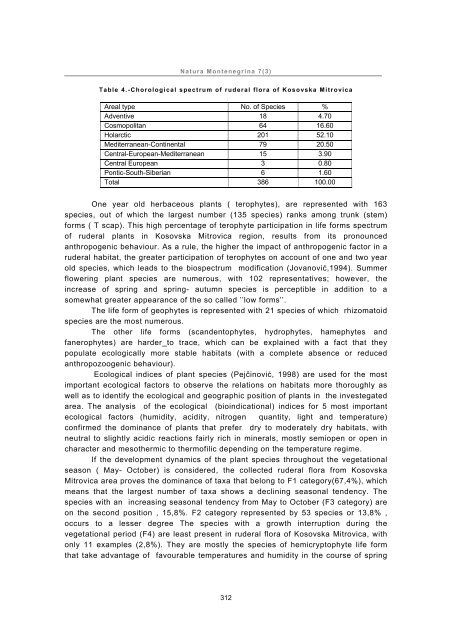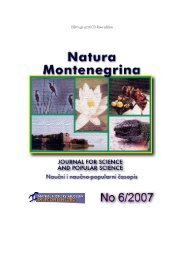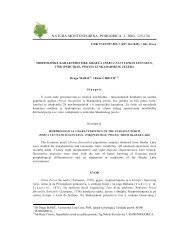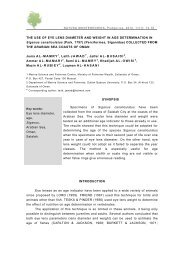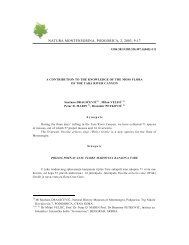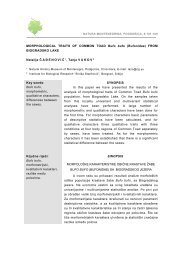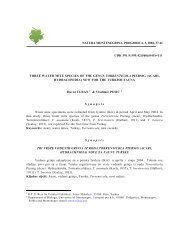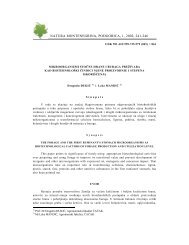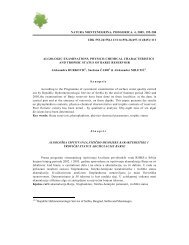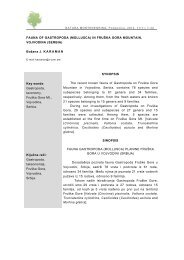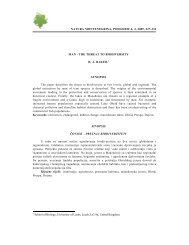ecological and phytogeographical characteristics of ruderal flora in
ecological and phytogeographical characteristics of ruderal flora in
ecological and phytogeographical characteristics of ruderal flora in
You also want an ePaper? Increase the reach of your titles
YUMPU automatically turns print PDFs into web optimized ePapers that Google loves.
Natura Montenegr<strong>in</strong>a 7(3)<br />
Table 4.-Chorological spectrum <strong>of</strong> <strong>ruderal</strong> <strong>flora</strong> <strong>of</strong> Kosovska Mitrovica<br />
Areal type No. <strong>of</strong> Species %<br />
Adventive 18 4.70<br />
Cosmopolitan 64 16.60<br />
Holarctic 201 52.10<br />
Mediterranean-Cont<strong>in</strong>ental 79 20.50<br />
Central-European-Mediterranean 15 3.90<br />
Central European 3 0.80<br />
Pontic-South-Siberian 6 1.60<br />
Total 386 100.00<br />
One year old herbaceous plants ( terophytes), are represented with 163<br />
species, out <strong>of</strong> which the largest number (135 species) ranks among trunk (stem)<br />
forms ( T scap). This high percentage <strong>of</strong> terophyte participation <strong>in</strong> life forms spectrum<br />
<strong>of</strong> <strong>ruderal</strong> plants <strong>in</strong> Kosovska Mitrovica region, results from its pronounced<br />
anthropogenic behaviour. As a rule, the higher the impact <strong>of</strong> anthropogenic factor <strong>in</strong> a<br />
<strong>ruderal</strong> habitat, the greater participation <strong>of</strong> terophytes on account <strong>of</strong> one <strong>and</strong> two year<br />
old species, which leads to the biospectrum modification (Jovanović,1994). Summer<br />
flower<strong>in</strong>g plant species are numerous, with 102 representatives; however, the<br />
<strong>in</strong>crease <strong>of</strong> spr<strong>in</strong>g <strong>and</strong> spr<strong>in</strong>g- autumn species is perceptible <strong>in</strong> addition to a<br />
somewhat greater appearance <strong>of</strong> the so called ’’low forms’’.<br />
The life form <strong>of</strong> geophytes is represented with 21 species <strong>of</strong> which rhizomatoid<br />
species are the most numerous.<br />
The other life forms (sc<strong>and</strong>entophytes, hydrophytes, hamephytes <strong>and</strong><br />
fanerophytes) are harder to trace, which can be expla<strong>in</strong>ed with a fact that they<br />
populate <strong>ecological</strong>ly more stable habitats (with a complete absence or reduced<br />
anthropozoogenic behaviour).<br />
Ecological <strong>in</strong>dices <strong>of</strong> plant species (Pejč<strong>in</strong>ović, 1998) are used for the most<br />
important <strong>ecological</strong> factors to observe the relations on habitats more thoroughly as<br />
well as to identify the <strong>ecological</strong> <strong>and</strong> geographic position <strong>of</strong> plants <strong>in</strong> the <strong>in</strong>vestegated<br />
area. The analysis <strong>of</strong> the <strong>ecological</strong> (bio<strong>in</strong>dicational) <strong>in</strong>dices for 5 most important<br />
<strong>ecological</strong> factors (humidity, acidity, nitrogen quantity, light <strong>and</strong> temperature)<br />
confirmed the dom<strong>in</strong>ance <strong>of</strong> plants that prefer dry to moderately dry habitats, with<br />
neutral to slightly acidic reactions fairly rich <strong>in</strong> m<strong>in</strong>erals, mostly semiopen or open <strong>in</strong><br />
character <strong>and</strong> mesothermic to therm<strong>of</strong>ilic depend<strong>in</strong>g on the temperature regime.<br />
If the development dynamics <strong>of</strong> the plant species throughout the vegetational<br />
season ( May- October) is considered, the collected <strong>ruderal</strong> <strong>flora</strong> from Kosovska<br />
Mitrovica area proves the dom<strong>in</strong>ance <strong>of</strong> taxa that belong to F1 category(67,4%), which<br />
means that the largest number <strong>of</strong> taxa shows a decl<strong>in</strong><strong>in</strong>g seasonal tendency. The<br />
species with an <strong>in</strong>creas<strong>in</strong>g seasonal tendency from May to October (F3 category) are<br />
on the second position , 15,8%. F2 category represented by 53 species or 13,8% ,<br />
occurs to a lesser degree The species with a growth <strong>in</strong>terruption dur<strong>in</strong>g the<br />
vegetational period (F4) are least present <strong>in</strong> <strong>ruderal</strong> <strong>flora</strong> <strong>of</strong> Kosovska Mitrovica, with<br />
only 11 examples (2,8%). They are mostly the species <strong>of</strong> hemicryptophyte life form<br />
that take advantage <strong>of</strong> favourable temperatures <strong>and</strong> humidity <strong>in</strong> the course <strong>of</strong> spr<strong>in</strong>g<br />
312


